A crocheted blanket made of plush yarn can be cool in the summer and warm in the winter. This feature is due to the type of yarn and the knitting pattern, which is why the blanket retains heat and coolness well. Therefore, this product is often given as a gift or made by yourself for children. A plush blanket is suitable even for newborns.
How much yarn do you need?
A blanket crocheted from plush yarn has a hypoallergenic composition, which may also contain wool. Before you start knitting, you need to accurately calculate the amount of yarn, since plush threads differ from regular yarn.
The yarn looks fluffy and voluminous due to the pile, the length of which can reach 0.5 cm. Products made from such yarn are voluminous, soft and light. The composition of the yarn does not allow for rapid heat conduction and maintenance of microclimate, so it retains heat in cold weather and coolness in summer.

A preliminary calculation of yarn is made by knitting a square from it. It is more convenient to estimate a square measuring 10*10 cm. It is also washed and dried to understand how much the dimensions of the finished product change.
To do this, follow these steps:
- Measure the side of the dried square and calculate how many of these fragments will be needed for the finished product.
- The number of loops on one side is calculated based on 1 part of the square.
- Unravel the square and measure the length of yarn needed for this section.
- Multiply the length by the number of squares needed to make up the finished blanket.
If the yarn manufacturer does not provide information on the packaging about the length of the skein and only indicates the weight, then the knitted square is not unraveled - it is enough to weigh it.
From 1 m of standard plush yarn you get a 50*50 cm square. Therefore, for a baby blanket, take about 5 skeins weighing 100 g. Most often, such skeins are immediately formed for knitting a blanket measuring 1*1 m. If you need to knit a larger blanket, calculate 100 g of yarn per 20 cm of the product for openwork knitting or 50 g of yarn per 20 cm of the product for dense knitting.
When choosing plush yarn, the following factors are also taken into account:
- the consumption of thin threads is greater than that of bulky ones;
- a dense pattern requires more yarn than an openwork one;

- the yarn is flexible and does not deform;
- the loops are large - about 2 cm, so the knitting speed is faster than with simple yarn;
- knitting can be done with a crochet hook, knitting needles or by hand;
- There is yarn with ready-made loops on sale;
- for a summer blanket, yarn containing bamboo, cotton and micropolyester is more suitable;
- for winter blankets, choose yarn with a high wool and cotton content;
- yarn with a high content of acrylic and viscose tolerates washing well and gets dirty less.
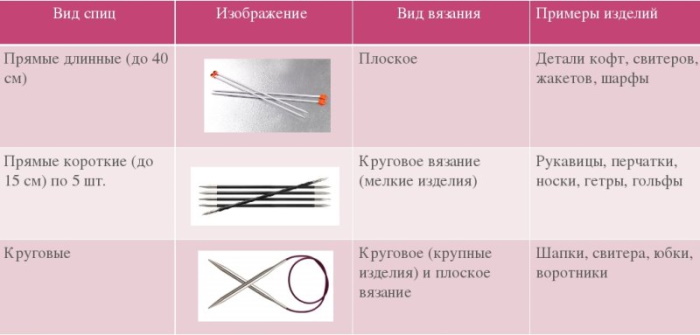
If you plan to knit the blanket not by hand, but with knitting needles, then choose long knitting needles. They are suitable for items with different patterns. To make a small blanket for a newborn, choose medium-length knitting needles (about 80 cm), their thickness is chosen based on the thickness of the yarn (usually from No. 3-6).
When knitting a blanket from plush yarn, follow some tips to ensure that the product is quick and looks neat.
| Recommendation | For what |
| They keep count of the rows and the loops in them. | It is difficult to count how many rows have already been made in a finished piece of fabric, so the count is kept during knitting. For convenience, keep a record or use a special counter. |
| Use markers to trace the design. | Without special markings it is difficult to follow the pattern. Markers mark the beginning and middle of a row, a certain number of loops, stages of decreasing and increasing loops. |
| Use bright lighting while working. | An additional lamp in the work area allows you to closely monitor the progress of knitting without damaging your eyesight. |
| Add and decrease stitches in a row anywhere. | The volume of the threads allows you to seamlessly adjust the number of loops anywhere in the row. |
| They simplify knitting the fabric according to the pattern. | When crocheting, the fabric can be made less dense, but the process is simpler. To do this, the 1st row is knitted according to the pattern: single crochet, 1 air loop and continue like this. In the next row, this order is changed and they continue knitting according to this pattern. |
| Add a thread of regular yarn of the same color. | To avoid getting tangled in the loops, add regular yarn in a matching color to the plush yarn. This product turns out denser and warmer, but less viscous. |
| Beginner knitters use a larger hook than indicated in the patterns. | The hook size is increased by 1 size to make the loops larger, making them easier to count and work with. |
Master class
A blanket made of plush yarn is crocheted with a tool of different sizes. To get more voluminous and large loops, choose a hook of size No. 8. If you are making a blanket or other product for children, then choose a hook of size No. 4 or 5. Then you do not have to hold all the loops at once, and if desired, you can replace it with your fingers.
Most patterns are suitable for hooks of 12-16 cm in length, regardless of the material (metal or plastic). It is recommended to choose a model with a handle to make the knitting process more convenient.
Beginner knitters are advised to start a blanket with simple patterns and gradually try more complex ones. This is done to master the knitting technique. If a mistake is made in the process, the entire row after it is unraveled, otherwise the pattern will be spoiled and the product itself will lose its appearance.
Zigzag pattern
A simple and beautiful crochet pattern is suitable for beginners, so it is used most often. This pattern is made with yarn of one color or supplemented with yarn of 2-3 other colors to emphasize the pattern and create the appearance of a three-dimensional pattern.
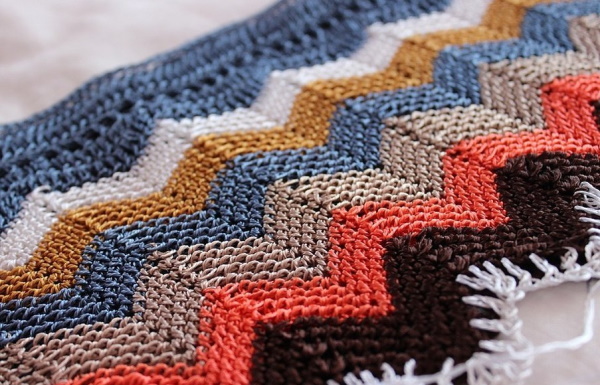
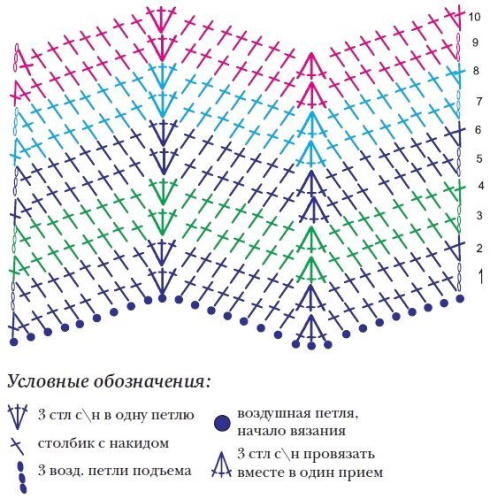
Follow the drawing step by step:
- First row – all loops are air loops.
- The second row - all double crochets. After 8 loops, form a bend - tie 3 columns together. After the next 8 loops, 3 columns are knitted from the air loop.
- Repeat the algorithm from step 2, rows 3-4.
- Change the color if desired and repeat all steps to the end.
Pattern "columns"
A blanket made of plush yarn with a crochet repeating pattern in the form of columns is often chosen when knitting blankets or other products due to its simple algorithm. If desired, the yarn is combined with threads of a different color, alternating rows, so that the finished product turns out more colorful.
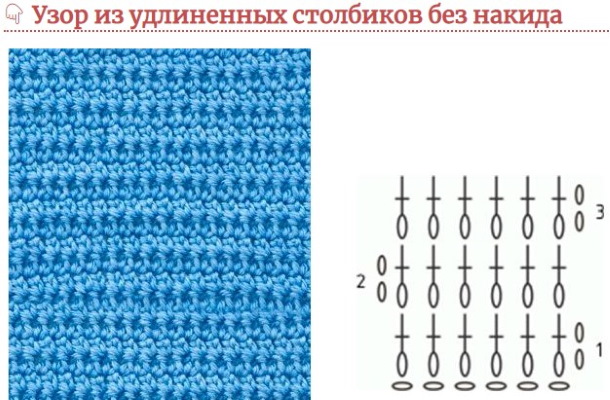
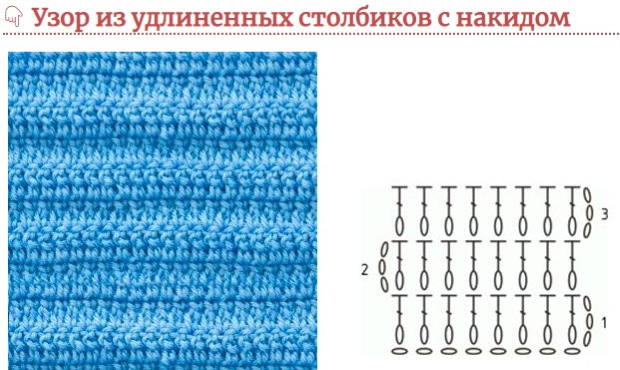
The algorithm includes the following steps:
- First row: calculate the required number of loops and knit them with air loops.
- All other rows are knitted only with double crochets.
Tick pattern
A blanket made of plush yarn with a crochet pattern in the form of repeating check marks is made from single-color threads or by alternating yarns of different colors to create a colorful blanket.

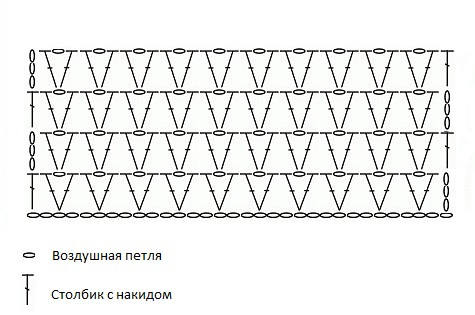
The pattern is performed in the following sequence:
- First row: cast on the required number of simple loops.
- Second row: 1 chain stitch, 2 double crochets, 1 chain stitch – repeat the pattern to the end. The bundle is knitted through every 2 stitches in the previous row.
- Third row: in each chain stitch, knit 2 double crochets and 1 chain stitch.
Blanket knitting
A blanket made of plush yarn is knitted with knitting needles by more experienced craftswomen, since it is more difficult to cope with bulky yarn with this tool than with a hook or hands. At the same time, a product knitted with knitting needles turns out more uniform.
Knitting needles are chosen with a long line so that the voluminous loops do not fall off during knitting. The thickness of the knitting needles for working with plush threads is chosen to be at least 5 mm.
Braided pattern
An easy to make and beautiful pattern that requires a lot of yarn due to the dense pattern. Due to the voluminous loops, the length of the knitting needles is not always enough to set the desired length of the product, so the knitting needles are often replaced by hand.
The side loops are made with simple columns with or without a yarn over using a crochet hook or knitted with knitting needles by default.

Cast on the required number of loops and then repeat 2 rows until the end of knitting:
- In the first row, knit 2 loops to the left.
- In the second row, knit 1, knit 2 loops together to the right. The last loop is knit.
Honeycomb pattern
A blanket knitted using the honeycomb pattern has a front side and a back side. If you want to make a blanket with a double-sided pattern, then you use garter stitch, where only the front loops are repeated in all rows.
To make a honeycomb blanket, cast on the required number of loops in the classic way and then repeat the pattern of 4 rows until the end of knitting. At the end, close the loops. In the diagram, all loops are indicated by the abbreviation 1 letters.
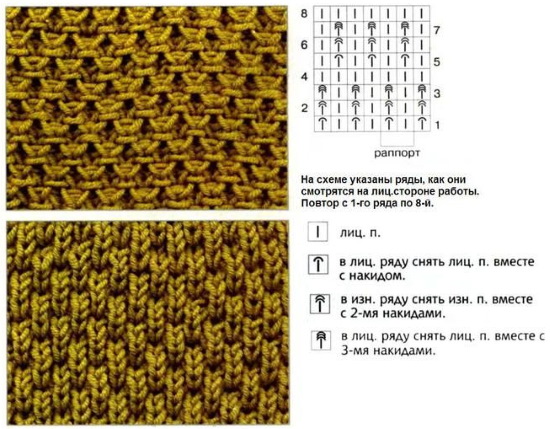
Step by step:
- First row: 1L, (2 together to the right, 2 together to the left, 2L (repeat the algorithm to the end), side L.
- 2 together left, 2L, 2 together right.
- 2 together left, 2L, 2 together right.
- 1L, (2 together to the right, 2 together to the left, 2L (repeat the algorithm to the end), side L.
Rice pattern
A blanket with a double-sided rice pattern measuring 100 cm by 123 cm is knitted with 7 mm thick needles. For such a product, you will need 4 skeins of yarn (120 m per 100 g). Before starting knitting, you can make a 10 cm knitting sample (you will need about 12 loops) to understand what the knitting density will be and how the pattern looks on the product.
When moving from one skein of yarn to another, protruding ends of threads are formed in the fabric (when tying the skeins). It is recommended to leave them on the sides of the product. When the product is finished, the ends of these threads are hidden in the fabric using a simple thread with a needle.
To create a blanket, cast on 102 loops in the classic way and then repeat until the end of the 4th row of the pattern. At the end, leave a piece of thread to close the loops in any convenient way. In the diagram, the designation of the loops is shown by an abbreviated initial letter (side - "b", front - "l", etc.).

Step by step:
- 1B, (1L, 1I (repeat the algorithm to the end), 1B.
- 1B, (1I, 1L (repeat the algorithm to the end), 1B.
- 1B, (1I, 1L (repeat the algorithm to the end), 1B.
- 1B, (1L, 1I (repeat the algorithm to the end), 1B.
The blanket is left as is or decorated with tassels. The finished product is washed in warm water with diluted shampoo and dried horizontally on a towel.
Blanket made by hand without knitting needles
A blanket made of plush yarn is crocheted in small sizes, if you make an openwork pattern from bulky yarn or collect a large number of loops, then it becomes more convenient to work with your hands. There is a special plush yarn on sale, consisting of ready-made loops, for knitting which no tools are needed.
In this case, hands replace knitting needles or a hook. To do this, insert loops into each other, similar to the work of tools. A blanket made in this way turns out uniform and neat.
Stockinette stitch
A blanket measuring 1*1 m is made quickly, in a few hours. For this size of blanket you will need 5 balls of yarn (9 m of thread per 100 g).
If a skein of yarn runs out during knitting and another one is started, the last loop of the thread is cut with scissors at the base to make a thread. In the new ball, the first loop is treated in the same way and 2 threads are tied together, tightening them tightly. The tails are cut off and knitting continues.

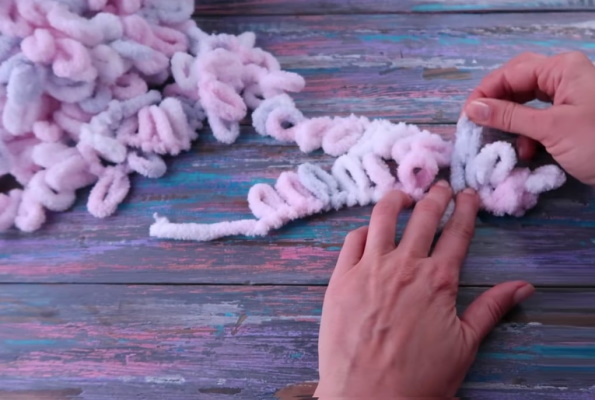
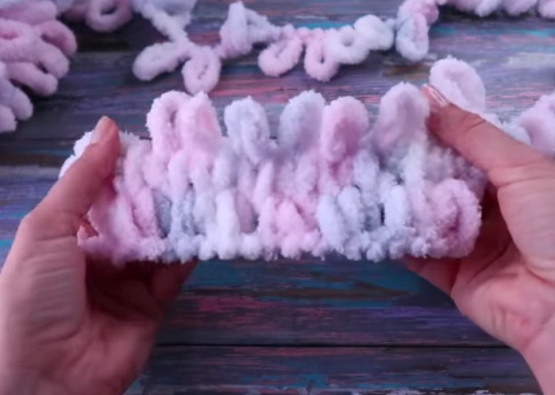
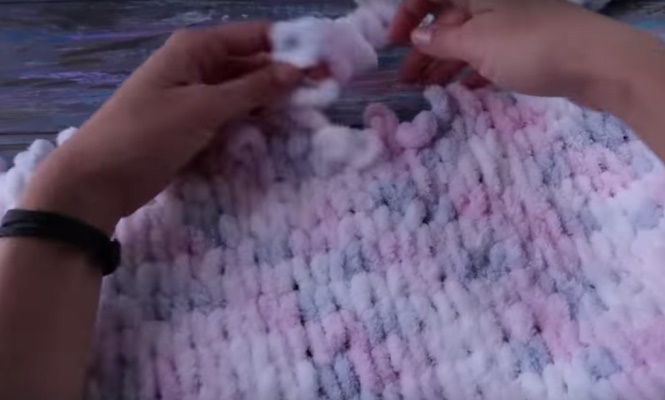

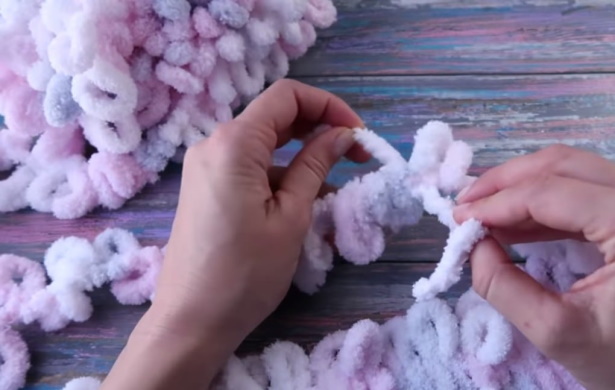
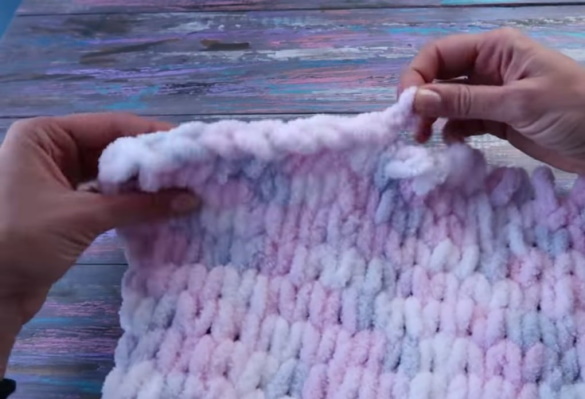
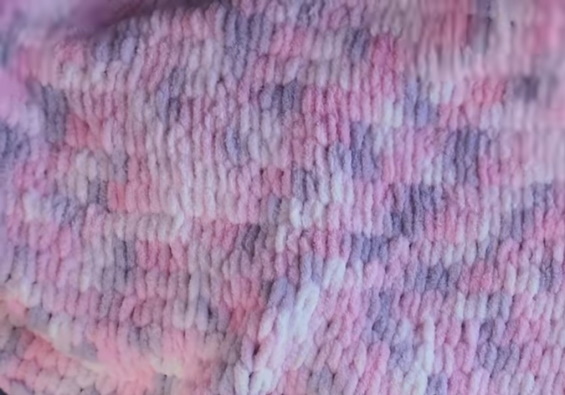
Step by step:
- Count 50 loops. The edge of the thread with loops remains on the left.
- The 50th loop is pulled through from behind into the previous loop. The next loop on the thread (51st) is also pulled through from behind into the 48th loop. And so on, each next loop on the thread is pulled through into the previous loop of the row. The row is finished according to this pattern.
- Turn the thread with loops to the right and pull the free loop into the previous knitted one from behind. Repeat the algorithm from step 2.
- Turn the thread each time and continue knitting the blanket to the end using the same algorithm.
- To close the edge, go to the beginning of the last row. Here, each previous loop is put on top of the next loop in the row. Start with the very first loop and continue to the end of the row. Cut off the next loop in the free thread after the last loop in the row.
Cut the free loop at the base to form a tail of thread, pull it through the last loop 2 times and tighten it tightly. Cut off the tails of the threads at the beginning and end of knitting.
Network
For a blanket measuring 80*90 cm, you will need 5 skeins of yarn with ready-made loops (90 m per 100 g). The blanket is made in a short period of time. The pattern is suitable for beginner knitters, as well as those who do not know how to knit.

When working, try to keep the loops in the thread straight and even, without twisting. Those who work with such yarn for the first time will find it easier to control the pattern by calculating the number of loops in each row - it always remains unchanged in this pattern.
The blanket is created using the following algorithm:
- The first loop in the thread is broken at the base. Then 50 loops are counted.
- The first row is knitted from right to left, and the loops are crossed in the same direction. If the row is from left to right, the crossing of the loops also changes direction. The 50th and 49th loops are crossed. The 50th loop is placed on top from left to right.
From the working thread, pull 2 free loops from the bottom one by one - first into the 49th, then into the 50th loop. Step back to the left, cross the loops again, pull the loop from the working thread from the bottom.


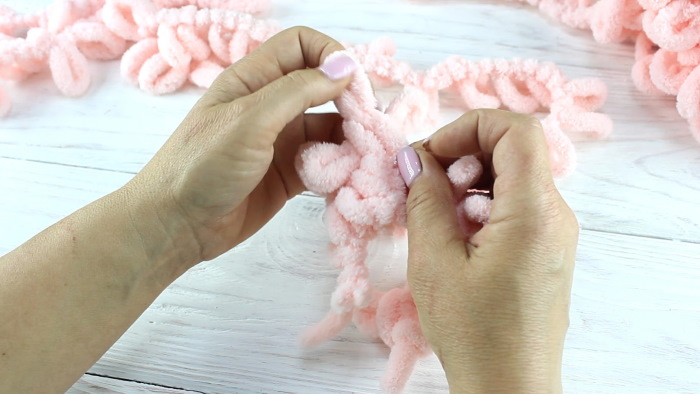
- In all even rows, the side loops are not knitted, they are skipped each time. In the second row, the knitting movement goes from left to right. Take the next loop after the side loop, cross it over the next one in the row in the direction to the right.
Pull 1 free loop from the working thread into these 2 crossed loops. Continue this algorithm until the end of the row.
- Before the third row, cross the unknitted side loop from the edge from right to left. Pass 1 free loop through them from below, as in the algorithm above. Continue knitting the 3rd row to the end.
- Continue knitting the blanket using the same pattern.
- When the blanket is finished and it is time to close the fabric, the working thread with free loops is left aside on the right. Loops are closed from left to right. The leftmost loop is put on top of the next one in the row.
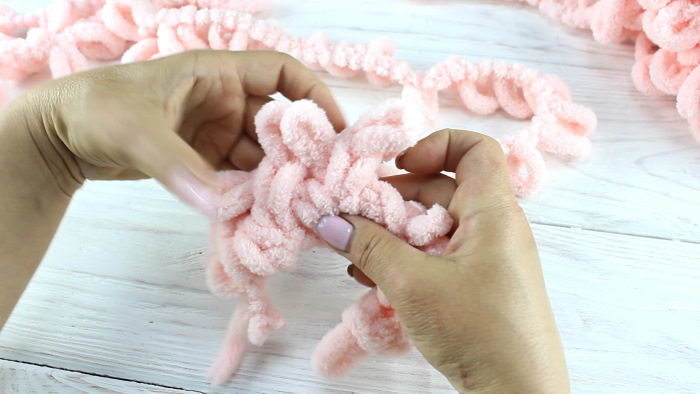
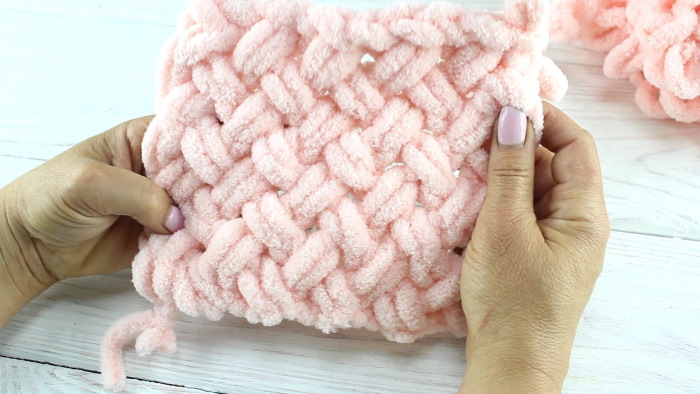

Continue to close loops in this manner further down the row. The last loop in the row is put on top of the loop in the working thread, pulled tight and cut off.
Rhombuses
To knit a blanket measuring 35*45 from yarn with ready-made loops, use 1 skein of yarn with ready-made loops. To do this, set aside loops that are a multiple of 6 and 2 side loops. For a small baby blanket, 26 loops are enough. The working thread with loops is placed from left to right.
Step by step:
- At the beginning of the knitting process, 2 loops of symmetry are knitted. To do this, 25 and 26 loops are crossed and crossed so that the 25th loop lies on the top right. The next free loop along the working thread is threaded into the 25th loop from below. Then the next loop along the working thread is threaded into the 26th loop from below.
- The next 4 loops in the row are knitted as faces. For this, loops on the left and right of symmetry are used. Loops on the right are inserted into loops on the left. The knitting pattern goes to the left.

- The next 2 loops in the row are crossed to the right (as in step 1) and the loops from the working thread are threaded into them from below.
- Continue the algorithm of steps 1-2 to the end of the 1st row. At the end, 2 loops remain, which are crossed to the right and knitted from below.
- The 2nd row is knitted on the front side and moves from left to right. The first loop is knitted as a regular front loop. The next 2 loops in the row are crossed to the right and knitted from the bottom.
Then 2 loops are regular, 2 loops are crossed to the left and knitted, 2 loops are crossed to the right and knitted from below, 2 loops are regular, 2 are crossed to the left, 2 loops are crossed to the left. Continue this algorithm to the end of the row. At the end of the row, the last 2 loops are crossed to the left and 1 loop remains, which is knitted as usual.
- The 3rd row is also not turned. Continue knitting from right to left. Side loops are always knitted. Pattern: 2 regular loops, 2 crossed to the left, 2 crossed to the right, 2 regular, 2 crossed to the left, 2 crossed to the right, 2 regular. Continue the pattern to the end of the row. Finish the row with 2 regular loops.
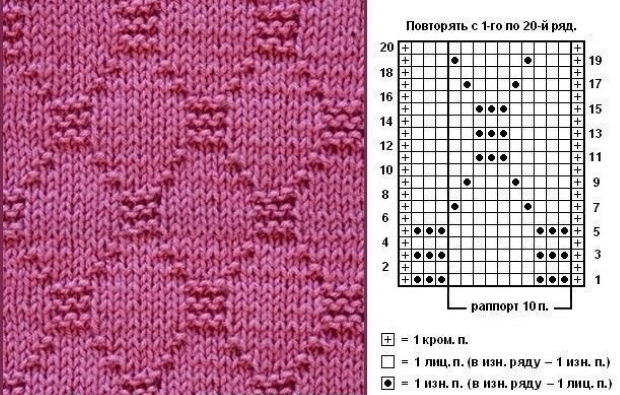
- 4th row: 3 regular, 2 loops crossed to the right, 3 regular (symmetry loops), 4 regular, 2 loops crossed to the right. Continue the pattern to the end of the row. At the end of the row, 3 regular loops.
- 5th row: 2 regular, 2 loops to the right, 2 loops to the left, 2 regular, 2 loops to the right, 2 loops to the left. Continue the pattern to the end.
- 6th row: regular loop, 2 loops to the left, 2 regular, 2 loops to the right, 2 loops to the left, 2 regular. Continue the pattern to the end.
- Continue knitting, repeating the entire pattern from rows 1-6.
- Close the row by knitting 2 loops - 1 from the previous row and 1 from the working thread. Then cover the next loop in the row with the finished loop. Continue to close the row according to the pattern, observing all the crosses. Knit the last loop, tighten and cut the end of the thread.
Children's models
The most common way of knitting a baby plush blanket among craftswomen is considered to be the “granny square” pattern. In this case, the knitting process continues in rows not from end to end, as in standard methods, but from the center to the edges of the square.
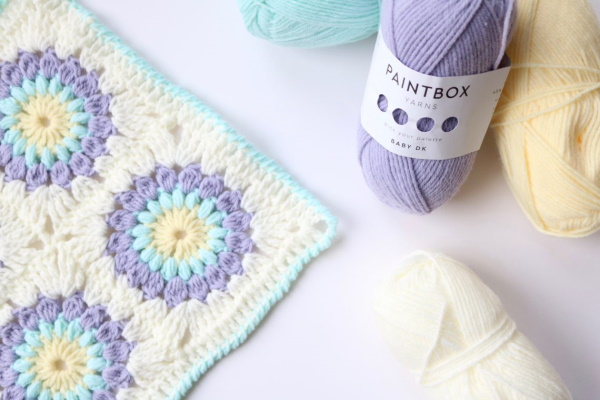


To do this, knit separate squares, there can be several types. In total, about 4-5 rows of 3-5 different squares are used. If desired, alternate several colors of yarn to get a motley pattern, similar to a patchwork blanket.
To knit a square, follow these steps:
- 3 air loops are tied into a circle.
- Knit a row: 3 double crochets, 2 chain stitches. The stitches are knitted from the chain stitches of the previous row.
- Next row: 8 double crochets and 8 chain stitches.
- In the next row the algorithm is the same, but there are 12 columns and loops.
- In the 4th row the number of elements increases to 16.
When all the squares are finished, they are tied together into a single piece. The blanket can be left as is, or decorated.
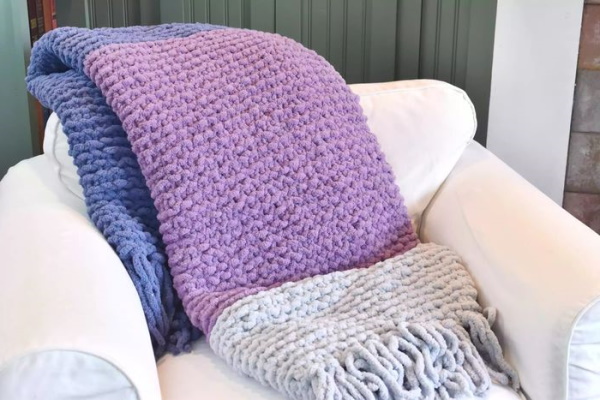 | 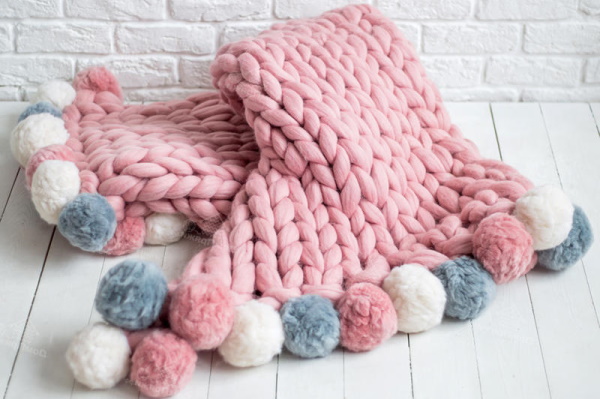 |
There are several options for decorating blankets:
- tassels on the corners of the product;
- fringe on all sides of the blanket;
- knitted lace on all sides of the product;
- pompoms around the perimeter of the product.
You can crochet a blanket from plush yarn in a few hours using a simple face stitch. The hook can be replaced with knitting needles for more complex patterns or you can use your hands. Depending on the type of yarn, pattern and size of the product, you may need a different number of skeins, but you will always need several.
Creating a 10*10 cm or other size pattern helps to accurately calculate the required amount of thread, where craftswomen can calculate the number of loops in a row and see how much thread is needed to create a pattern.
Video about knitting
Plush yarn blanket crochet:
